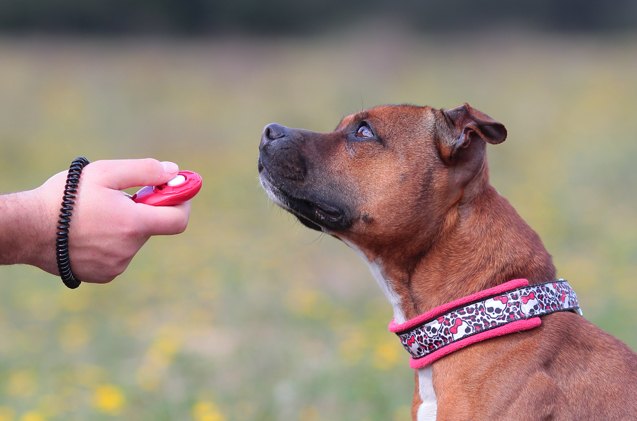Should I Train My Dog With a Clicker?

When training your dog, certain tools can help the learning process. A go-to tool for many trainers is a clicker: a simple device that fits in your palm and makes a unique “click” noise when you push its button. It works to mark the moment a dog does the behavior you were asking.
For instance, if you cue your dog to sit, you would click the moment his rear end touches the floor. Then, you’d follow up with a treat or other reward. This is the same mark-and-reward sequence as if you said “good boy!” or “yes” the moment he sits. Whether using a word or a clicker, marking tells the dog that he just did the “right” thing, and the reward encourages him to do it again and again. This is how he learns to sit, lie down, or do any other behavior. So why use an extra tool to do a job your mouth can do?
Related: 6 Easy Ways to Train Your Dog Every Day
Advantages to Using a Clicker
- A clicker provides a clearly audible, consistent sound. This gives the dog very clear feedback, compared to your voice, which has many variations. (Think of all the different ways you could say “yes!”) It also is easier for your dog to hear a clicker if you are training in a noisy environment.
- Some dogs have tuned out their humans’ voices. (By dog standards, humans talk a lot.) A clicker has only one meaning — to mark a behavior before the reward comes — so dogs learn to love the sound.
- Some people have more accurate timing when they mark with clickers than with their voices, which means clearer communication and faster learning.
- Dogs can get motivated to work harder in order to get more clicks. They see it as a game that they can “win” by doing certain behaviors or tricks.
- Clickers are useful when teaching a complicated behavior that requires may small steps. For instance, some dogs are hesitant to lie down on cue, so you can break it into increments. First click for lowering his head, then lowering it further, then a shoulder drop, then a full down.
Related: On-Leash Dog Greetings: Yea or Nay?
Disadvantages to Using a Clicker
- A clicker is one more tool to juggle. Clickers come in many forms, even slipping on your finger like a ring, but you’re still carrying one more piece of equipment.
- Occasionally dogs are startled by the sound of the clicker. You can get around this by buying a quiet clicker or by clicking from inside your pocket. You should also spend extra time conditioning your dog to the clicker by simply clicking and treating, clicking and treating, to teach your dog how awesome this noise is.
- If you or others in your house use the clicker for anything other than marking a behavior, the clicker will lose its appeal.
- You don’t use the clicker forever. It is only intended for teaching new behaviors, during which time you will treat after every click. (If you don’t follow with a treat, the clicker loses its “power” and becomes another meaningless sound.) Sometimes owners aren’t sure when to stop using the clicker.
So, back to the question, “Should I train with a clicker?” It’s really up to you. Because a clicker leads to clearer communication between you and your dog, I think it is well worth the small hassle of carrying one more item. To learn all about how to introduce, train with, and teach your dog games with a clicker, check out clickertraining.com.

Kate Naito, CPDT-KA, is a dog trainer at Doggie Academy in Brooklyn, NY, and author of the training book, "BKLN Manners." She draws upon her experience as an educator and dog trainer to apply positive training techniques to a challenging urban environment. Kate is a rescue advocate drawn to special-needs dogs and currently has two Chihuahua mixes, Batman and Beans.
More by Kate Naito























